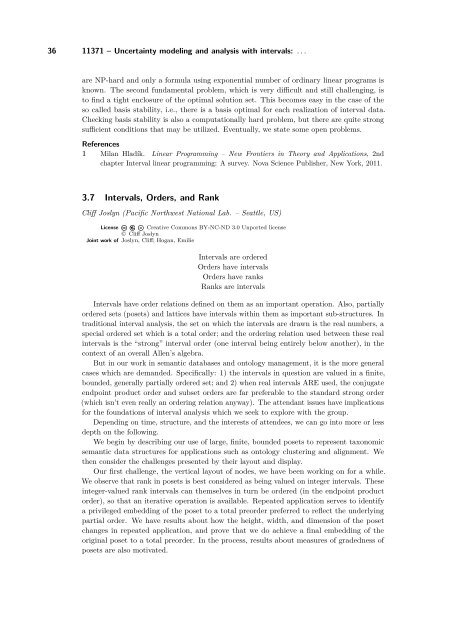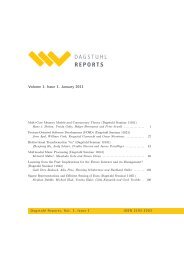Uncertainty modeling and analysis with intervals - DROPS - Schloss ...
Uncertainty modeling and analysis with intervals - DROPS - Schloss ...
Uncertainty modeling and analysis with intervals - DROPS - Schloss ...
Create successful ePaper yourself
Turn your PDF publications into a flip-book with our unique Google optimized e-Paper software.
36 11371 – <strong>Uncertainty</strong> <strong>modeling</strong> <strong>and</strong> <strong>analysis</strong> <strong>with</strong> <strong>intervals</strong>: . . .<br />
are NP-hard <strong>and</strong> only a formula using exponential number of ordinary linear programs is<br />
known. The second fundamental problem, which is very difficult <strong>and</strong> still challenging, is<br />
to find a tight enclosure of the optimal solution set. This becomes easy in the case of the<br />
so called basis stability, i.e., there is a basis optimal for each realization of interval data.<br />
Checking basis stability is also a computationally hard problem, but there are quite strong<br />
sufficient conditions that may be utilized. Eventually, we state some open problems.<br />
References<br />
1 Milan Hladík. Linear Programming – New Frontiers in Theory <strong>and</strong> Applications, 2nd<br />
chapter Interval linear programming: A survey. Nova Science Publisher, New York, 2011.<br />
3.7 Intervals, Orders, <strong>and</strong> Rank<br />
Cliff Joslyn (Pacific Northwest National Lab. – Seattle, US)<br />
License Creative Commons BY-NC-ND 3.0 Unported license<br />
© Cliff Joslyn<br />
Joint work of Joslyn, Cliff; Hogan, Emilie<br />
Intervals are ordered<br />
Orders have <strong>intervals</strong><br />
Orders have ranks<br />
Ranks are <strong>intervals</strong><br />
Intervals have order relations defined on them as an important operation. Also, partially<br />
ordered sets (posets) <strong>and</strong> lattices have <strong>intervals</strong> <strong>with</strong>in them as important sub-structures. In<br />
traditional interval <strong>analysis</strong>, the set on which the <strong>intervals</strong> are drawn is the real numbers, a<br />
special ordered set which is a total order; <strong>and</strong> the ordering relation used between these real<br />
<strong>intervals</strong> is the “strong” interval order (one interval being entirely below another), in the<br />
context of an overall Allen’s algebra.<br />
But in our work in semantic databases <strong>and</strong> ontology management, it is the more general<br />
cases which are dem<strong>and</strong>ed. Specifically: 1) the <strong>intervals</strong> in question are valued in a finite,<br />
bounded, generally partially ordered set; <strong>and</strong> 2) when real <strong>intervals</strong> ARE used, the conjugate<br />
endpoint product order <strong>and</strong> subset orders are far preferable to the st<strong>and</strong>ard strong order<br />
(which isn’t even really an ordering relation anyway). The attendant issues have implications<br />
for the foundations of interval <strong>analysis</strong> which we seek to explore <strong>with</strong> the group.<br />
Depending on time, structure, <strong>and</strong> the interests of attendees, we can go into more or less<br />
depth on the following.<br />
We begin by describing our use of large, finite, bounded posets to represent taxonomic<br />
semantic data structures for applications such as ontology clustering <strong>and</strong> alignment. We<br />
then consider the challenges presented by their layout <strong>and</strong> display.<br />
Our first challenge, the vertical layout of nodes, we have been working on for a while.<br />
We observe that rank in posets is best considered as being valued on integer <strong>intervals</strong>. These<br />
integer-valued rank <strong>intervals</strong> can themselves in turn be ordered (in the endpoint product<br />
order), so that an iterative operation is available. Repeated application serves to identify<br />
a privileged embedding of the poset to a total preorder preferred to reflect the underlying<br />
partial order. We have results about how the height, width, <strong>and</strong> dimension of the poset<br />
changes in repeated application, <strong>and</strong> prove that we do achieve a final embedding of the<br />
original poset to a total preorder. In the process, results about measures of gradedness of<br />
posets are also motivated.













